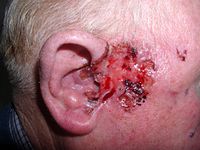
Photo from wikipedia
Skin substitutes can provide a temporary or permanent treatment option for chronic wounds. The selection of skin substitutes depends on several factors, including the type of wound and its severity.… Click to show full abstract
Skin substitutes can provide a temporary or permanent treatment option for chronic wounds. The selection of skin substitutes depends on several factors, including the type of wound and its severity. Full-thickness skin grafts (SGs) require a well-vascularised bed and sometimes will lead to contraction and scarring formation. Besides, donor sites for full-thickness skin grafts are very limited if the wound area is big, and it has been proven to have the lowest survival rate compared to thick- and thin-split thickness. Tissue engineering technology has introduced new advanced strategies since the last decades to fabricate the composite scaffold via the 3D-bioprinting approach as a tissue replacement strategy. Considering the current global donor shortage for autologous split-thickness skin graft (ASSG), skin 3D-bioprinting has emerged as a potential alternative to replace the ASSG treatment. The three-dimensional (3D)-bioprinting technique yields scaffold fabrication with the combination of biomaterials and cells to form bioinks. Thus, the essential key factor for success in 3D-bioprinting is selecting and developing suitable bioinks to maintain the mechanisms of cellular activity. This crucial stage is vital to mimic the native extracellular matrix (ECM) for the sustainability of cell viability before tissue regeneration. This comprehensive review outlined the application of the 3D-bioprinting technique to develop skin tissue regeneration. The cell viability of human skin cells, dermal fibroblasts (DFs), and keratinocytes (KCs) during in vitro testing has been further discussed prior to in vivo application. It is essential to ensure the printed tissue/organ constantly allows cellular activities, including cell proliferation rate and migration capacity. Therefore, 3D-bioprinting plays a vital role in developing a complex skin tissue structure for tissue replacement approach in future precision medicine.
Journal Title: International Journal of Molecular Sciences
Year Published: 2022
Link to full text (if available)
Share on Social Media: Sign Up to like & get
recommendations!